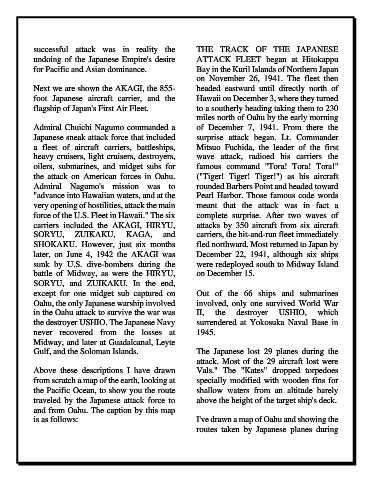Page 1537 - Dive the Seas and More-2
P. 1537
successful attack was in reality the THE TRACK OF THE JAPANESE
undoing of the Japanese Empire's desire ATTACK FLEET began at Hitokappu
for Pacific and Asian dominance. Bay in the Kuril Islands of Northern Japan
on November 26, 1941. The fleet then
Next we are shown the AKAGI, the 855- headed eastward until directly north of
foot Japanese aircraft carrier, and the Hawaii on December 3, where they turned
flagship of Japan's First Air Fleet. to a southerly heading taking them to 230
miles north of Oahu by the early morning
Admiral Chuichi Nagumo commanded a of December 7, 1941. From there the
Japanese sneak attack force that included surprise attack began. Lt. Commander
a fleet of aircraft carriers, battleships, Mitsuo Fuchida, the leader of the first
heavy cruisers, light cruisers, destroyers, wave attack, radioed his carriers the
oilers, submarines, and midget subs for famous command "Tora! Tora! Tora!"
the attack on American forces in Oahu. ("Tiger! Tiger! Tiger!") as his aircraft
Admiral Nagumo's mission was to rounded Barbers Point and headed toward
"advance into Hawaiian waters, and at the Pearl Harbor. Those famous code words
very opening of hostilities, attack the main meant that the attack was in fact a
force of the U.S. Fleet in Hawaii." The six complete surprise. After two waves of
carriers included the AKAGI, HIRYU, attacks by 350 aircraft from six aircraft
SORYU, ZUIKAKU, KAGA, and carriers, the hit-and-run fleet immediately
SHOKAKU. However, just six months fled northward. Most returned to Japan by
later, on June 4, 1942 the AKAGI was December 22, 1941, although six ships
sunk by U.S. dive-bombers during the were redeployed south to Midway Island
battle of Midway, as were the HIRYU, on December 15.
SORYU, and ZUIKAKU. In the end,
except for one midget sub captured on Out of the 66 ships and submarines
Oahu, the only Japanese warship involved involved, only one survived World War
in the Oahu attack to survive the war was II, the destroyer USHIO, which
the destroyer USHIO. The Japanese Navy surrendered at Yokosuka Naval Base in
never recovered from the losses at 1945.
Midway, and later at Guadalcanal, Leyte
Gulf, and the Soloman Islands. The Japanese lost 29 planes during the
attack. Most of the 29 aircraft lost were
Above these descriptions I have drawn Vals." The "Kates" dropped torpedoes
from scratch a map of the earth, looking at specially modified with wooden fins for
the Pacific Ocean, to show you the route shallow waters from an altitude barely
traveled by the Japanese attack force to above the height of the target ship's deck.
and from Oahu. The caption by this map
is as follows: I've drawn a map of Oahu and showing the
routes taken by Japanese planes during

